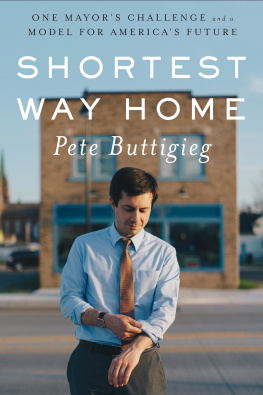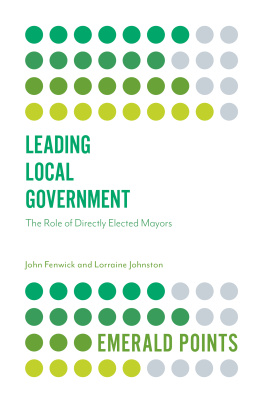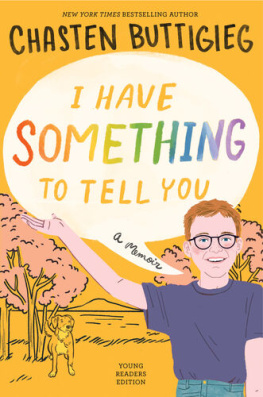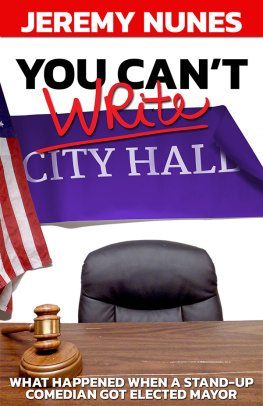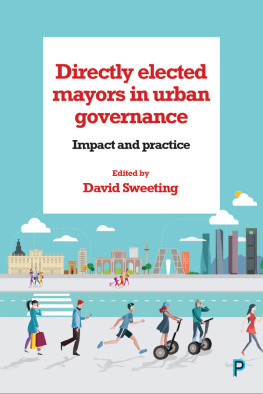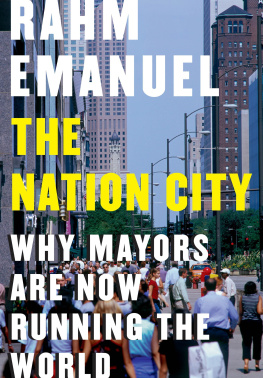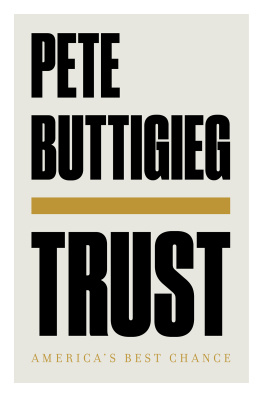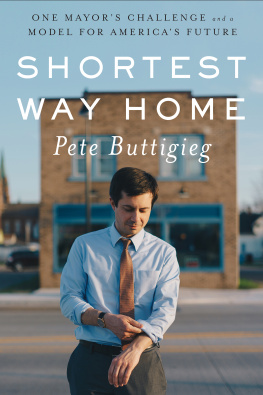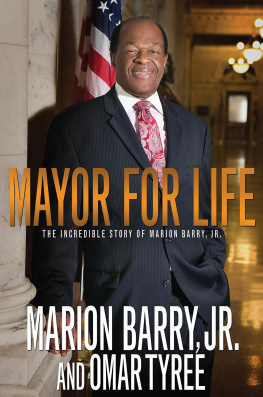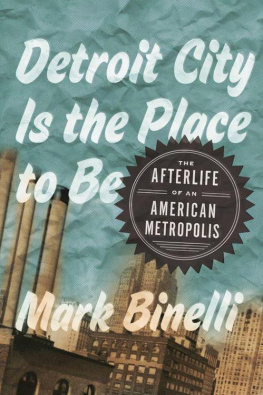Contents
Guide


Copyright 2019 by Pete Buttigieg
All rights reserved
First Edition
For information about permission to reproduce selections from this book, write to Permissions, Liveright Publishing Corporation, a division of W. W. Norton & Company, Inc., 500 Fifth Avenue, New York, NY 10110
For information about special discounts for bulk purchases, please contact W. W. Norton Special Sales at specialsales@wwnorton.com or 800-233-4830
Designer: Ellen Cipriano
Production manager: Julia Druskin
The Library of Congress has cataloged the printed edition as follows: is available
ISBN 978-1-63149-436-9
ISBN 978-1-63149-437-6 (ebk.)
Liveright Publishing Corporation, 500 Fifth Avenue, New York, N.Y. 10110
www.wwnorton.com
W. W. Norton & Company Ltd., 15 Carlisle Street, London W1D 3BS
Everyones own homeland is Kashmir to him.
AFGHAN PROVERB
CONTENTS
D awn comes late here along the western limit of the Eastern Time Zone, so far from the coast that our first sunrise of the year arrives after eight in the morning. Most January days are cloudy, making sunup a hidden and gradual process, less a moment of daybreak than a cold shift away from the illuminated night, in which the cloud ceiling and the snow cover reflect the sodium streetlights between them into an orange glow so bright you can read the paper outside at four in the morning.
So the first hint of morning actually makes things seem darker, as the amber night light yields and the sky deepens into a kind of electric indigo. The species of light evolve around you, from luminous ambience to discrete points of light along the horizon, the general giving way to the specific.
Looking at this scene from the fourteenth-floor windows of the mayors corner office, its easy to imagine that you are in the wheelhouse of a ship at sea. Adding to the effect, if its windy out, the air pushes and pulls the picture windowpanes, making a noise far out of proportion to the winds actual strength, as though the entire building is buffeted by a great gale. A few snowflakes whirl out of the air and fly up across the reflection of your fluorescent-lit face, and you feel like touching a piece of furniture to make sure you are steady.
It was that kind of deep winter morning on New Years Day 2012, my first day as mayor of South Bend, a city of one hundred thousand people in northern Indiana. My hometown. Peering out across my empty desk into the lingering blue of a slow-motion midwinter dawn, the sky no longer orange but not yet gray, I pondered what to do with my first few minutes of unscheduled time.
Day One had commenced early with a visit to the Street Department garage to encourage the plow crews, and a stop at Memorial Hospital to greet Caleb, the first newborn of the new year. Now I was upstairs in my new office, and there was plenty on the schedule for the rest of the day, building up to the formal swearing-in ceremony set for that evening. But in this unstructured moment, what exactly should I do? Go over the speech one more time? Open my new city government email? Check the weather again, I quickly decided, and find out how the plows are doing.
Snow, of course, can be a beautiful thing. It is the great benefactor of children, promising canceled school and hot chocolate and downhill sledding. But it is the mortal enemy of any mayor it touches. One days worth of bungled plowing is all that stands between a mayor and political disaster. At a minimum, as Mike Bloomberg experienced, a rough or mishandled snowstorm can bring days of criticism; at worst, as Chicagos Michael Bilandic and New Yorks John V. Lindsay learned the hard way, it spells career oblivion. Even after it melts, mayors curse the past winters snowfall, because it invariably refreezes to become the progenitor of a mayors other great enemy and prey: the pothole.
A S I LEARNED GROWING UP , snow can be a great unifier in a place like South Bend. When a storm is past and the glinting winter sun emerges, so do we with our shovels, and as water drips from icicles along garage gutters we appear in our alleys to dig out our cars. It becomes a social activity based on cheerful neighborly commiseration. Snow furnishes the grounds for conversationand even though we pride ourselves on being able to handle it, a good enough snowstorm can supply conversational fodder for weeks or even years to come. Like rain for the English, snow to a South Bender is worthy of intensive discussion even though, or perhaps because, it is so familiar.
Ask anyone who is old enough to remember, and they will tell you all about the Blizzard of 78. According to my parents, it was still the universal conversation starter even two and a half years later, when they arrived on College Street with their U-Haul from Texas, not long before I was born.
Have you heard about the Blizzard of 78? someone would ask as you were pumping gas, waiting in the checkout line at Martins Super Market, or slicing into your roasted chicken at a dinner party. And once the question is asked, it makes no difference how you answer. Prepare to hear about the Blizzard of 78.
B Y LATE J ANUARY THAT COLD YEAR , there were already a couple feet of snow on the ground. Forecasters knew a storm was coming on that Thursday, January 26, perhaps a serious one, but no one realized it would be historic. The mayor was traveling, so Pete Mullen, the city controller, was in charge by default.
By the time he arrived at work, as the snowfall gathered speed, it had already been a terrifying day for Pete. He had started his usual morning routineshower, shave, putting on a suitand was getting some coffee when he paused to check on his two-week-old infant and realized that the child had stopped breathing. The baby was scarlet-red; no air was coming out of his mouth. Pete turned him over and patted him on the back. Still nothing. Sprinting upstairs with the infant in hand, he woke his alarmed wife and handed the child to her while grabbing the phone to call 911.
Soon there were police cars, a fire truck, and an ambulance at the houseas Pete recalled, When they hear its a baby, they pull out all the stops to get there. It wasnt snowing yet, at least not much. A paramedic stuck something in the babys throat and opened his passageway, and soon he was healthily inhaling and exhaling. Pete rode in the ambulance to the emergency room at St. Joseph Hospital, where the familys pediatrician was waiting, while Mary Lou waited anxiously at the house with their other kids. Once it was confirmed that the boy was all right, the doctor offered to give Pete and the baby a ride home, then take Pete to the office.
So by the time he arrived on the fourteenth floor at noon, Pete Mullen was already drained. But it was clear now that this storm was going to be a big deal. I can picture Pete looking out at the same view I see now, noting the shrinking visibilityfirst you cant see the West Side anymore, then all you can see are the buildings across the street, then just the courthouse down below, and finally nothing at all but a dull white glow where your view of the city ought to be.
By midafternoon, Pete was telling everyone to get home but be ready to come in the next day. Not willing to risk leaving the office and being himself unable to get back, he found a couch and spent the night there, waking up five hours later with his suit still on. As the winds blew snow into drifts ever higher, stranding cars and burying neighborhoods, Pete would stay in the office for two more nights, manning the citys response. On Thursday, temperatures fell to zero and winds peaked at fifty-five miles per hour as the bulk of what would be a three-foot snowfall struck the city head-on. But it was the drifts that set records, piling up ten feet or even more.

